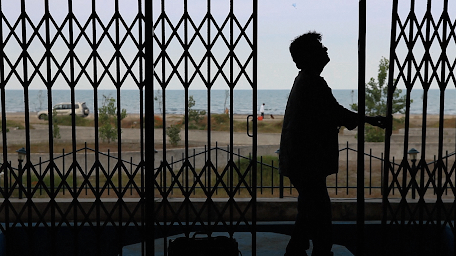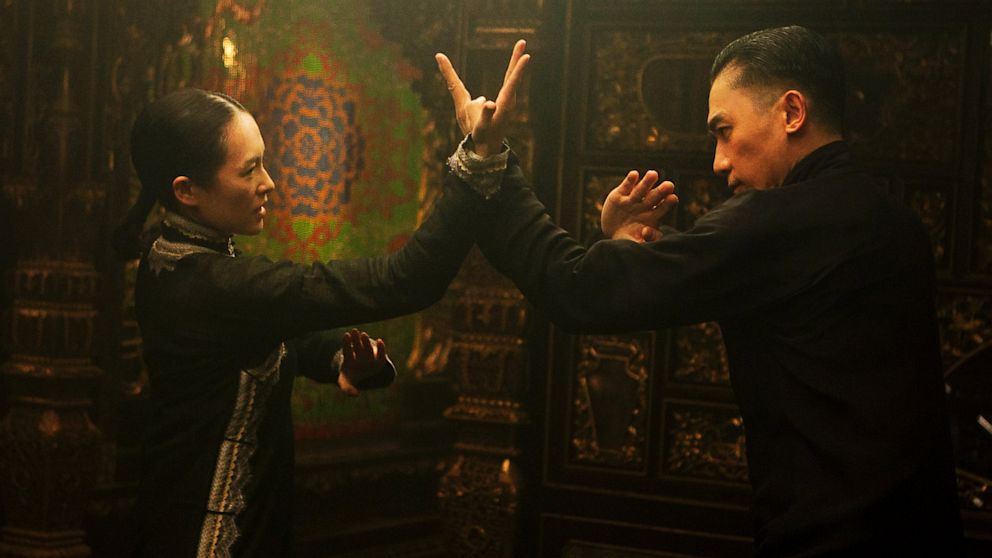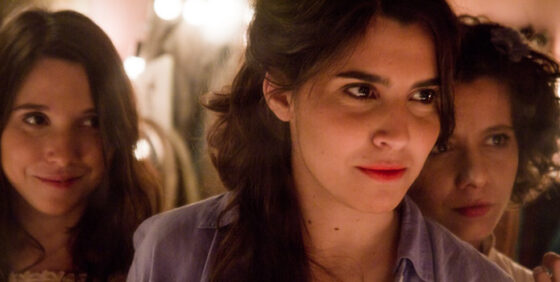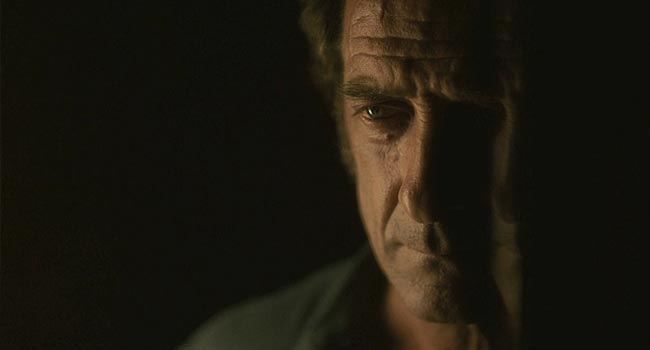The impetuous and darkly facetious
Lars von Trier is back with a two-in-one hat-trick,
Nymph()maniac (2014). It tells the story of Joe (
Charlotte Gainsbourg), a self-professed nymphomaniac who embarks upon a life-revisiting confession to Seligman (
Stellan Skarsgard), a middle-aged man who takes her in after finding her lying, beaten up and unconscious, in a damp alleyway. As he listens to the recollections of Joe’s many tumultuous and colorful sexual adventures—they never bring solace to this bored and compulsive soul—suspicion grows that Seligman's care and attention are far too kind to be driven solely by noble and selfless intentions…
As the spelling of the film(s)’ title indicates, the first volume focuses on the
‘Nymph’ stage; while the second, more violent part, has to do with the
‘Maniac’ side of its titular character, emphasizing a brutal dialectical rapport between youth and adulthood, boredom and pain, beauty and ugliness, which turn out, in an indirect but sobering way, to be utterly universal. With this apparently vapid ‘pornographic’ diptych, the Danish director may have found the most profound expression of his cinema, namely one that is at once profoundly didactic/demonstrative (a
film à thèse) while pushing the boundaries of self-referentiality (to
Epidemic, most clearly, but also the anti-naturalistic, almost Brechtian acting found in many of his films), irreverent playfulness and irony to the very limits.
Nymph()Maniac also gives us at long last what von Trier always seemed to teeter on, often breaking down his films into chapters, namely a form of ‘cinematic novel’. The frame narrative of the film, constantly interrupted à la
Tristram Shandy, is in itself perfect material for a dark comedy, and it titillates one to see how far von Trier is going to push the parallel with several Marquis de Sade books, wherein a young woman is taken in by an apparently well-meaning man who turns out to be an even greater sadist than the ones she met earlier. Other more punctual references to literary classics include Nabokov’s
Lolita, or the greatest poet of grotesque and sublime eroticism who ever set word to paper, Georges Bataille. As for the film’s ‘chapters’
per se, Joe’s recollected stories, as in a picaresque novel, introduce random characters which are often jubilant grist for the Dane’s comedic mill: in the first film, special mention ought to go to Uma Thurman as an apodictic cuckolded wife, as she bursts into Joe’s apartment with her children in order to show them ‘the whoring bed’, to much comic effect. Yet all these scenes in the first film constantly elude the proverbial punch. In similar anticlimactic fashion, it ends with young Joe (model
Stacy Martin) claiming to her lover (
Shia LaBeouf) that she can’t experience orgasms anymore, the image fading in the most cheap fade fashion into the credits. The latter are accompanied by footage from part two, wherein other familiar von Trier character actors appear, and of far more grotesque qualities:
Willem Dafoe,
Jean-Marc Barr and the inenarrable
Udo Kier, for what promises to take us into the darker,
‘Maniac’ part of the narrative, where all hell will break loose.
In spite of its pronounced literariness, far from feeling like an unrealized book, this film creates a perfectly original—if heavily derivative—form of this hybrid, between the purity of the nymph and the provocation of the maniac, and the gaping hole in the middle, the disquieting mystery (and meaninglessness) of life, all bathed in a jarring, absurdist humor. Like the grotesque bodies it bares naked,
Nymph()Maniac never shies away from exposing this aspect, opening on a series of mysterious and beautiful shots of walls and pipes in a snowy alleyway (evocative of 1950s Japanese cinema), followed by the nihilistic chords of Rammstein’s heavy and foreboding music—the tone of dark irony and excess of the film set from the get go. And the conversations between Joe and Seligman, filmed mostly with fixed shots and in a dull interior are starkly counterbalanced by the postmodern pastiche that constitute each recollected story/chapter, all boast a different visual style, filled with playful elements of
mise-en-scène where von Trier seems to nod toward Hal Hartley more often than to his much revered Andrey Tarkovsky—although the episodic and formally diverse looks also reference
The Mirror, in a rather irreverent way. This, needless to say, makes for a highly original, but also heavy to digest, mix. Admittedly the various episodes could become quite tiresome, were the film a single opus. As for the segues which stitch the various chapters together, peppered with Joe’s awkward non-sequiturs and Seligman’s eager displays of pedantic erudition (from fishing techniques to Bach and Fibonacci’s number) they are so preposterously arbitrary and contrived in their effort at imparting structure (and therefore control) onto the universe, i.e. giving meaning to what has none, that they can only elicit laughter (or at least a satisfied grin) in the audience.
But all of the above doesn’t do justice to the participative dimension of the film—during the short narratives that Joe tells Seligman, it is the question of veracity rather than the picaresque erotic adventures which fascinates the viewer. We become the investigators, never fully identified with Joe or Seligman, trying to see through their lies: Seligman claims to be Jewish, yet his wall shows a Christian Orthodox icon. And while he tells Joe that he is asexual, the lecherousness deep in his voice and the eagerness with which he spurs her on betray his further, darker intent—as much as his sexual frustration and the limits of his super-ego. Joe, for that matter, could be lying too, but it is her ambiguity which makes her titillating: as she recounts, in a fragile, almost angelic voice, a story that is so utterly comedic and implausible, it seems as though most of it is pure fabrication. This is allegorized in the way a bruised and beat-up Charlotte Gainsbourg projects herself as the young Stacy Martin. Phony and hokey, the dialogues also constantly remind us of the falseness and pretenses of the characters: Joe, for instance, often delivers her story in an impeccable English, but will pause at words pronounced by Seligman that she couldn’t possibly not know otherwise, yet sheepishly insisting that she doesn’t, inviting more pedantic elaborations from the older man. But it isn’t the lies she tells so much as the story she never reveals which give the film its psychoanalytical interpretive key: if it seems quite clear that Joe didn’t have a fraction of the sexual experiences she professes to, the question of her loving, idealized father’s role (
Christian Slater) in shaping her psychosexual profile remains suspended. But its presence, the poetic lyricism of the early years, clearly idealized and contradicted by the father’s dark delirium on his deathbed and Joe’s lubricating at the sight of it, elegantly suggests Freudian explanations without actually bringing them to the fore, eliding and leaving heavily pregnant the incestuous, melodramatic cliché. Constantly going from lies and fabrications to the next, all the while feebly explained and ‘boxed up’ by Seligman, the film allegorizes the manipulative and enticing nature of cinema itself: a constant work of deception and engulfment to which we develop a fetishistic and libidinal attraction.
Those disparaging critics who derided the film as pretentious and boring are at once spot-on and dead wrong.
Nymph()maniac cultivates boredom like the greatest works of modern literature did: with relish and distinction. This distinguished ennui becomes utterly fascinating as we are forced to contemplate the very fabric of the film, indeed becoming its writers instead of the readers of the film. This participative stance is invigorating, and has seldom been witnessed in recent art-house cinema, harking back to the great triumphs of the 1960s, but with von Trier’s added postmodern gimmicky pauses, which are indeed pretentious but also endearing in the way in which they unmask the mad hatter that is the director, all the while keeping us guessing as to what this wildly original and creative mind is made of—perhaps a mixture of childish imagination and cruelty with the maturity and weathered perversion of a (dirty) old man, itself referenced in the constant ebb and flow in the narrative between youth and jaded middle-age. And this is becoming insofar as the film narratizes the life of a proxy for the filmmaker, Joe being about von Trier’s age at the time of the making of the film, moving from the adorable child to the rugged, beat-up adult who lives in a world of dangerous fantasy. The scenes involving Joe as a child, for that matter, play to the music of Shostakovich’s jazz waltz, used most memorably in another faux sexy thriller,
Eyes Wide Shut, but more to the point here, in von Trier’s remarkably kitsch commercial directed in the early 90s for the French insurance company CNP, where a child traverses several decades and becomes an adult in a faux one-take lateral tracking
shot.
Lars von Trier is a master of (self-)advertising and promotional coups, and so it is probably very cynically that he has marketed his
Nymph()Maniac for what it is not (cf. Paul Verhoeven's
Showgirls), namely a film filled with sexual tension and enticing erotic material—the film, at least in its theatrical version, features far less nudity and eroticism than, say,
Blue is the Warmest Color. Whenever the film comes anywhere close to becoming arousing (mostly thanks to the rather unambiguously beautiful body of Martin), the director playfully reverts to the grim interior of Seligman and Joe’s bruised and fatigued features. This is a film about the sexual frustration and utter deprivation of an erotic life in most of the Western world, and as such it serves as a brilliant indictment of that very state of things; or at least it does show how pornography reifies the body and sucks passion and meaning out of physical ‘love’.
Even though the film is definitely not about its ending, I shall not reveal it for those who might care about Seligman’s and Joe’s wretched fates and all their many glaring contradictions, discursive and otherwise. The film’s finale continues, however tamed, the grand climaxes of
Antichrist and
Melancholia, wherein vindication or cataclysms are completely thwarted by a profound nihilism, adding another layer of meta-commentary on the senselessness of existence and, more to the point, on the lack of pertinence of the vast majority of cinema today, equating it with the episodic, procrastinating and addictive nature of TV shows and the raw and monotone nature of pornography, two of the (sadly) major ‘cultural’ phenomena of the early 21st media.
Nymph()Maniac, a paradoxical miracle of a film(s), will leave the viewer wanting, whetting a welcome appetite—specifically for good cinema, a thirst that can never truly be quenched. In this, the film brilliantly establishes a parallel between its characters’ compulsions and us spectators, caught face to face with our sobering condition and destiny.





























